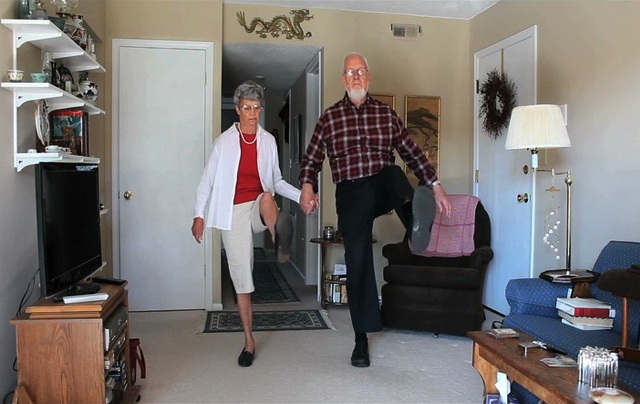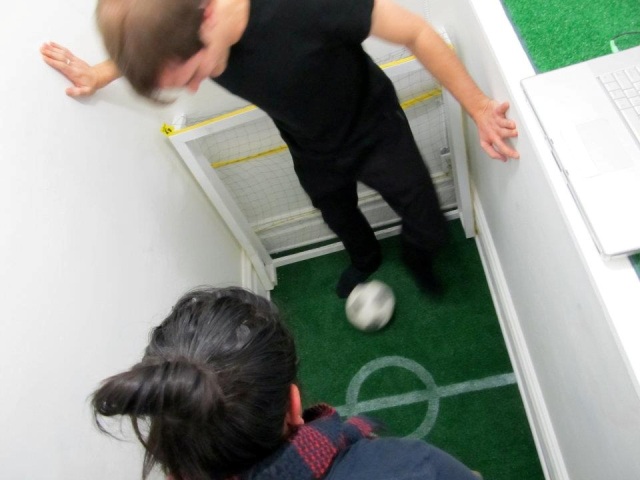Artists That Work: Jake Myers
By Staff in Arts & Entertainment on Nov 29, 2012 8:30PM

Commodore Gilgamesh of Everything is Terrible as seen in Don't Quit.
Jake Myers is the driving force behind Don't Quit, a new interactive art exhibit opening 5:30 p.m. today at the Chicago Cultural Center that combines exercise with video art. Don’t Quit is comprised of video contributions from over 20 artists who have pioneered new ways to get your heart rate up, while Myers leads spectators through the exercises illustrated in the videos.
Myers sustains a prolific output around Chicago through an eclectic portfolio of gallery-sized sporting events (Short Court), photographs depicting Captain Planet going through an existential crisis, or by hosting wrestling matches out of his apartment gallery The Octagon. Chicagoist recently met up with Myers to discuss the development of Don’t Quit, working out with his Mom, and his dream of collaborating with Shaquille O’Neal.
Chicagoist: If I am not mistaken, this is your second workout video that you have organized. Can you talk about how this project first started and if it has changed at all since its first iteration?
Jake Myers: This is actually the third workout that I've made. The first one I made for Jennifer Montgomery's Moving Image class where I went back to the suburbs and created a Talking Heads workout with the other five members of my family.
The second workout was called "You Better Work" and it was a collaboration with TheHood Internet. They put together this amazing, bizarre and danceable workout mix as the driving audio. Then, I organized an "exquisite corpse" where several video artists took a chunk of the audio and made mini-workouts that could all be played in sequence.
I guess these were mostly inspired by the weird workout videos I would do with my family. My favorite was Total Body Sculpt with Gilad where he would have his mom on the show and they would have really funny banal conversations while working out. My mom and I would do these aerobic tapes in the living room and giggle while trying to stay in shape.
C: Is it crucial for the spectator to follow along with the moves in the workout?
JM: Yes.
C: I get the feeling that you will have to play the role of the hype man, instructor, or coach to make sure that everyone participates during the screening. Is it necessary that you be in attendance during the screening to perform this role? If so, this makes the workout videos a buttress to a performance piece and vice versa. You have organized a context of workout videos to help flesh out your role as the athletic instructor. Do you see yourself as the Gilad of the Gilads?
JM: Yes, I am going to take on this hype-man persona with a microphone and a lack of self-awareness. The presence of this loud, silly character seems to make people take themselves less seriously and encourages participating in this absurdist exercise. The weirdest part about performing as this character is that you start to believe it and start using words like "amped" or "pumped" non-ironically.

Artist E. Aaron Ross's Grandparents lead the workout in Don't Quit.
C: You don’t shy away from creating a spectacle with your work, which can be seen in your photography, the Short Court series, as well as some the exhibitions you have curated. You seem to be equally inspired by the spectacle in sporting events, pop culture, and technology. Do you try to alter how the spectacle is perceived? Especially, when the spectacle is placed in an art gallery context?
JM: I like this question and feel like I could talk a lot about it. I grew up programming computers, working at an outlet mall and playing sports. I was ingrained in the "Society of the Spectacle" and I was unsure about it's mechanisms but never really had the language or context to communicate this skepticism.
Then I went to art school where I was exposed to Guy Debord and Paulo Freire and was given a framework to respond to the spectacle of sport, consumerism and heteronormativity in general. So, I really try to create these situations that deal with spectacle and utilize some of the same aesthetics but incorporate Marxist and Situationist undertones. I want artists and athletes to be in the same room, enjoy the strange spectacle and walk away feeling curious about the "other."

Myers’ "Short Court" at MEΣ(s)A Project Space.
C: You definitely straddle that line between the world of sports and art but you do it by bringing the spectacle of sporting events into the art world. An art exhibition at a gallery is inherently part of the art world. Have you ever reversed this approach and brought your visual art practice into the world of sports?
JM: Jeriah Hildwine asked me this same question a while ago and I'm still not sure how to answer that. My experience is that doing anything outside of the norms established in sports contexts costs you points or gets you in trouble. I would frequently get yelled at for performative gestures while playing volleyball in high school.
C: Who do you think your audience is, and, what would your ideal audience look like?
JM: I think my audience right now is my friends from high school, my friends from art school, volleyball players, students and my family.
My ideal audience would be all of the previously mentioned plus a few collectors or risk-taking corporate sponsors who have an idiosyncratic drive to finance more ambitious projects I have on the back burner. Also, I think that Shaquille O'Neal might appreciate what I'm doing and maybe we can collaborate on an art show.
C: Like many Chicago artists, you have also taken to curating. What compelled you to get involved in organizing art exhibitions?
JM: Some of my friends from school started curating in domestic spaces. I loved how fun, personal and affordable these art events were in comparison to the institutional or commercial counterparts. So I started the Pentagon Gallery with Michael Garcia and now run the Octagon Gallery out of my apartment in the West Loop.
C: Did you feel that curating was a mandatory step as an artist living in Chicago?
JM: Having a community is important and curating definitely helped me meet a lot of people. Also, I guess my art practice tends to float between artist, organizer and curator so it made sense for me but I don't know that it's mandatory for all artists.
C: I know that you work as an art teacher at a local charter school. I’m interested in how artists make a living in Chicago because, for most, it is definitely not from the sales of art. So, if it is not too sensitive of a subject, I was hoping you could talk about how you see the relationship between your teaching and your artistic output. Do you think you have struck a balance with the two or do want to thrive solely from your art production?
JM: Teaching is great, my students at Jones College Prep are incredible, we talk about art critically every day and we go over production techniques every day. So, it forces me to consider various perspectives, research artists and try to remain accessible. In this respect, I think that teaching supports making art and vice versa. However, teaching is a full time job and I feel like having more studio and production time would allow more freedom to play and more time to intentionally craft certain aspects of my work.
C: Do you have any other projects coming up that you want to talk about?
JM: Yes, Friday, January 4 at the Museum of Contemporary Art in Chicago. I'm organizing and performing in an event titled Fight Night: Resolution. It's a series of duel-based performances happening on the first floor of the Museum.
C: How are feeling about the Chicago Bears so far?
JM: I'm a jerk. I make so much art about sports and love playing sports but I don't really watch them. Unless it's Olympic Volleyball, I could watch that for hours. I'm a big fan of Giba from the Brazilian men's indoor team.
C: Anything else you want to say in this interview?
JM: Don't quit.
Get your heart rate up at the Chicago Premiere of Don’t Quit on Thursday, November 29, at 5:30pm in the Chicago Cultural Center's Preston Bradley Hall.
— Christopher Smith